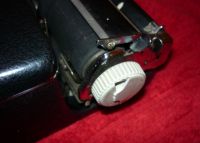So this is the way to avoid all that damage and hassle. Start by putting the right and left margins together in the middle of the carriage. If the machine has a carriage lock, engage it and hold it down with an elastic band if possible. If you are the patient sort, you can cut a cardboard quadrant shape to hold the typebars down, jamming the point of the quadrant underneath the centre guide. Alternatively, place a ball of bubble-wrap or crushed newspaper in the type-basket. The idea is to prevent the typebars from lifting in transit. Remember that the machine is likely to be carried upside down or on its side at several points in its journey. If you can find a way of jamming the shift (elastic bands holding the shift keys up can work well) - so much the better.
If the machine has a carry case, it is important to make sure that the typewriter cannot rattle about inside! A 'clip over' case (where the closed bottom of the typewriter becomes the side of the case when carried by the handle) is usually a close enough fit. A larger carry case, especially where the typewriter is not fixed to a baseboard, will need extra packing. Again, imagine what might happen when the case is turned upside down and violently shaken ! Bubble-wrap is ideal, but balls of crushed newspaper will do, if you use enough of them.
Having immobilised the machine inside its carry case, wrap the case in a polythene bag or bin liner. It is not unknown for parcels in transit to be left outside in the rain or stood in a puddle ! If there is no carry case, put a thick layer of bubble-wrap around the typewriter, then bag it. You will need a sturdy cardboard box at least two inches (50mm) bigger all round than the typewriter. The kind of box that computer and electrical equipment arrives in, is ideal.
Make a layer of packing material at least one inch (25mm) deep on the bottom of the box, and place the typewriter on it. Now fill the sides and top with packing, making sure that the machine is firmly wedged. Temporarily close the box and shake it. If you can feel anything moving about, add more packing material. Remember - if you can shake it, the carrier will break it! Enclose a note with your name and address, then seal the box on all seams with heavy packing tape.
Using a thick, black, marker pen write the words 'DELICATE INSTRUMENTS' on each surface of the box. Add 'FRAGILE' labels if you have them, and draw 'This Way Up' arrows on all sides.
Despite your careful labelling, the package will be thrown around and turned upside down in transit. However, you will have the satisfaction of knowing that your precious typewriter will be safely protected inside its box. I have despatched many typewriters using this packing method, and haven't had one arrive damaged yet!






